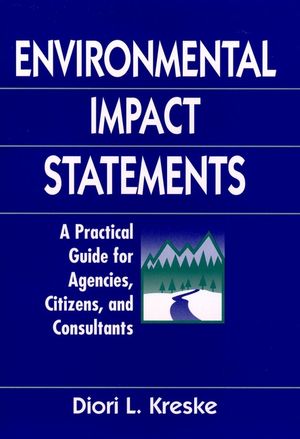Environmental Impact Statements: A Practical Guide for Agencies, Citizens, and ConsultantsISBN: 978-0-471-13741-2
Hardcover
512 pages
August 1996
 This is a Print-on-Demand title. It will be printed specifically to fill your order. Please allow an additional 10-15 days delivery time. The book is not returnable.
|
||||||
Environmental Impact Statements focuses on the roles of the variousparticipants in the EIS review process. Whether you are an EISauthor or reviewer, member of a public agency, a private sectorconsultant, a developer, environmental activist, or privatecitizen, understanding your own role and the roles of others in theprocess will increase your effectiveness, reduce duplication ofeffort, and save time and money.
This hands-on guide offers a unique, comprehensive approach topreparing, managing, and reviewing an EIS. It chronicles thepreparation process step by step, from kickoff meeting throughfinal submission and, unlike other books, it integrates technicaldiscussions on the regulatory environment and impact analysis intothe planning chronology instead of treating them independently. Thebook's combined emphasis on process and interaction of rolesenables participants to adapt each step to their own federal orstate EIS projects.
Author Diori Kreske explains all concepts needed to understand theEIS process and presents them first at an introductory level andlater in greater detail. In the first half of the book sheintroduces readers to the EIS process, defines the roles andresponsibilities of major participants, and discusses the processin relation to federal and state requirements and court decisions.Then Kreske concentrates on the nuts and bolts of preparing andmanaging an EIS. She describes how to build an EIS team, establishthe statement's framework, manage the preparation process,determine when and how to involve the public, and write and reviewEISs.
Whatever your role in the EIS process, and wherever your interestslie, this invaluable resource will help you develop a clearunderstanding of your responsibilities within the definedrequirements and ensure that the process will be more effective inaccomplishing its stated purpose: to reduce the negative impacts ofour actions on the environment.
Environmental Impact Statements is the first book to approach thepreparation and management of the EIS process through the roles andresponsibilities of process participants. It enables participantsto reduce conflicts, avoid duplication of effort, and mostimportantly, produce a more useful EIS. This invaluable bookprovides a step-by-step guide to preparing an EIS that can bereadily adapted to any state or federal EIS project. It also:
* Explains major participants' roles and how their responsibilitiesand goals can be effectively integrated into the process
* Describes the responsibilities and perspectives of both thepublic and private sectors
* Gives how-to advice on preparing and managing the EIS process
* Offers suggestions on how EIS teams can streamline the processand reduce time, effort, and paperwork
* Provides case studies that illustrate the preparation andmanagement of EISs
* Includes numerous illustrations, an extensive list of acronyms,and appendices useful in preparing EISs, including NEPA and CEQregulations
For anyone involved in the EIS process, this unique resource willmake you a more effective participant and help you produce a moreaccurate, reliable, and effective EIS.
This hands-on guide offers a unique, comprehensive approach topreparing, managing, and reviewing an EIS. It chronicles thepreparation process step by step, from kickoff meeting throughfinal submission and, unlike other books, it integrates technicaldiscussions on the regulatory environment and impact analysis intothe planning chronology instead of treating them independently. Thebook's combined emphasis on process and interaction of rolesenables participants to adapt each step to their own federal orstate EIS projects.
Author Diori Kreske explains all concepts needed to understand theEIS process and presents them first at an introductory level andlater in greater detail. In the first half of the book sheintroduces readers to the EIS process, defines the roles andresponsibilities of major participants, and discusses the processin relation to federal and state requirements and court decisions.Then Kreske concentrates on the nuts and bolts of preparing andmanaging an EIS. She describes how to build an EIS team, establishthe statement's framework, manage the preparation process,determine when and how to involve the public, and write and reviewEISs.
Whatever your role in the EIS process, and wherever your interestslie, this invaluable resource will help you develop a clearunderstanding of your responsibilities within the definedrequirements and ensure that the process will be more effective inaccomplishing its stated purpose: to reduce the negative impacts ofour actions on the environment.
Environmental Impact Statements is the first book to approach thepreparation and management of the EIS process through the roles andresponsibilities of process participants. It enables participantsto reduce conflicts, avoid duplication of effort, and mostimportantly, produce a more useful EIS. This invaluable bookprovides a step-by-step guide to preparing an EIS that can bereadily adapted to any state or federal EIS project. It also:
* Explains major participants' roles and how their responsibilitiesand goals can be effectively integrated into the process
* Describes the responsibilities and perspectives of both thepublic and private sectors
* Gives how-to advice on preparing and managing the EIS process
* Offers suggestions on how EIS teams can streamline the processand reduce time, effort, and paperwork
* Provides case studies that illustrate the preparation andmanagement of EISs
* Includes numerous illustrations, an extensive list of acronyms,and appendices useful in preparing EISs, including NEPA and CEQregulations
For anyone involved in the EIS process, this unique resource willmake you a more effective participant and help you produce a moreaccurate, reliable, and effective EIS.



